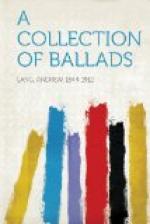JOHNIE FAA
From Pinkerton’s Scottish Ballads. The event narrated is a legend of the house of Cassilis (Kennedy), but is wholly unhistorical. “Sir John Faa,” in the fable, is aided by Gypsies, but, apparently, is not one of the Earls of Egypt, on whom Mr. Crockett’s novel, The Raiders, may be consulted. The ballad was first printed, as far as is known, in Ramsay’s Tea Table Miscellany.
HOBBIE NOBLE
The hero recurs in Jock o’ the Side, and Jock o’ the Mains is an historical character, that is, finds mention in authentic records, as Scott points out. The Armstrongs were deported in great numbers, as “an ill colony,” to Ulster, by James I. Sir Herbert Maxwell’s History of Dumfries and Galloway may be consulted for these and similar reivers.
THE TWA SISTERS
A version of “Binnorie.” The ballad here ends abruptly; doubtless the fiddler made fiddle-strings of the lady’s hair, and a fiddle of her breast-bone, while the instrument probably revealed the cruelty of the sister. Other extant versions are composite or interpolated, so this fragment (Sharpe’s) has been preferred in this place.
MARY AMBREE
Taken by Percy from a piece in the Pepys Collection. The girl warrior is a favourite figure in popular romance. Often she slays a treacherous lover, as in Billy Taylor. Nothing is known of Mary Ambree as an historical personage; she may be as legendary as fair maiden Lilias, of Liliarid’s Edge, who “fought upon her stumps.” In that case the local name is demonstrably earlier than the mythical Lilias, who fought with such tenacity.
ALISON GROSS
Jamieson gave this ballad from a manuscript, altering the spelling in conformity with Scots orthography. Mr. Child prints the manuscript; here Jamieson’s more familiar spelling is retained. The idea of the romance occurs in a Romaic Marchen, but, in place of the Queen of Faery, a more beautiful girl than the sorceress (Nereid in Romaic), restores the youth to his true shape. Mr. Child regarded the tale as “one of the numerous wild growths” from Beauty and the Beast. It would be more correct to say that Beauty and the Beast is a late, courtly, French adaptation and amplification of the original popular “wild growth” which first appears (in literary form) as Cupid and Psyche, in Apuleius. Except for the metamorphosis, however, there is little analogy in this case. The friendly act of the Fairy Queen is without parallel in British Folklore, but Mr. Child points out that the Nereid Queen, in Greece, is still as kind as Thetis of old, not a sepulchral siren, the shadow of the pagan “Fairy Queen Proserpina,” as Campion calls her.




